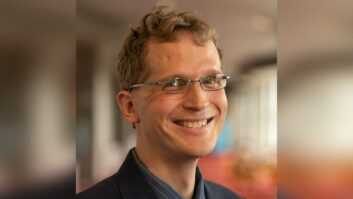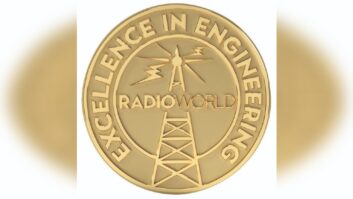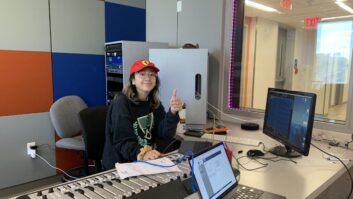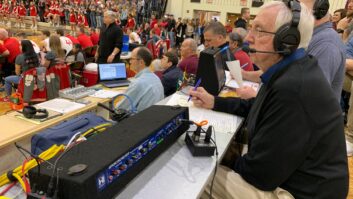
NAB’s Kevin Gage will keynote the Broadcast Engineering Conference. “Hybrid radio” is likely to be among his discussion topics.
credit: Photo by Jim Peck Expect to hear the phrase “hybrid radio” a lot at the Broadcast Engineering Conference of the NAB Show. Ditto for “all-digital AM,” “IP,” “AES67,” “connected car,” “NextRadio,” “EAS” and “my feet hurt.”
Radio World sifted through the agenda of radio-oriented sessions and identified the following as particularly promising. If you don’t like our list, well, we’re sorry. (But you can see the full one at www.nabshow.com.)
In our March 12 issue, we previewed the Broadcast Management Conference.
YES, EVEN PUBLIC ENGINEERS NEED INTERNET PROTOCOL
Public radio engineers will tell you they like to stay ahead of the curve. So it’s probably not surprising that they always meet before the NAB Show itself gets going.
“Engineering in an Increasingly IP Environment” is the theme of the 14th Public Radio Engineering Conference, Thursday and Friday, April 3–4.
NPR typically has a presence at PREC, of course; this year Senior Director of Engineering Shawn Fox will give an in-depth view of the network’s new headquarters, some photos of which we’ve published in Radio World. Fox will also talk later that day about disaster recovery plans at PRSS and NPR and about new concepts in master control.
Other NPR speakers on the agenda include Distribution Deputy Director of Quality Assurance and Functional Design Laura Jensen; System Architect David Julian Gray; Director of Technology Strategy Chris Nelson; and NPR Labs’ Director Rich Rarey and Senior Technologist John Kean. These are some pretty impressive titles; and if you want to hang out with the network’s tech crowd, here’s your chance to schmooze.
Several manufacturers will speak about IP-related subjects. Our eye also is caught by a dish heater project to be described by Aaron Read of Rhode Island Public Radio (only RW readers would get excited about a dish heater project); as well as a talk by Mark Persons discussing practical tips, and a promised presentation by Shane Toven of Wyoming Public Radio tantalizingly titled “Test Equipment Playground.”
Toven plans to bring test equipment — an exciter, a couple of handheld spectrum analyzers, portable modulation analyzer, oscilloscope, audio generator/analyzer — and give practical demonstrations along with Mark Persons.

ERI’s Tom Silliman listens intently at the keynote of BEC 2013.
credit: Photo by Jim Peck “The idea is to give younger engineers who may be more IT- than audio- and RF-savvy a chance to play around with some tools that they might not otherwise have had a chance to experience yet,” Toven told RW.
For info on PREC, visit www.apre.us.
KEVIN GAGE DRIVES A HYBRID
On Sunday morning, Kevin Gage again gives the keynote of the Broadcast Engineering Conference. He’s executive vice president and chief technology officer of the NAB.
In last year’s address, he said that broadcasters, when considering traditional strengths of radio like robustness, scalability and localism, we should include mobility too.
“The audiences we serve are increasingly mobile, and they want their media content along for the ride,” he said then. “Radio has long been a mobile service, but we can make it even more pervasive with its inclusion on more handheld devices, and its expanded service to vehicles through hybrid radio techniques.”
So you might be asking yourself, “Self, what is hybrid digital radio, anyway?”
Well, the European Broadcasting Union defines it as the combination of broadcast radio and broadband/IP technologies. RadioDNS, on which RW has reported, is an example; and you can see it on the exhibit floor. Another is the NextRadio app initiative pushed by Emmis Communications and others in the United States to create and encourage enhanced FM listening via smartphones.
So expect Gage to say “hybrid radio” a lot this year. Indeed, his emphasis is likely to carry over to show Monday, when he moderates a featured three-hour session called “Hybrid Radio: Making It Happen at Your Station.”
Show up for that and you will hear from Paul Brenner, senior vice president and chief technology officer of Emmis, who we suspect will provide an update on NextRadio; as well as from a person who can bring a carmaker perspective and talk about hybrid radio’s chances in the dashboard. That’s Scott Burnell, Ford Motor Co.’s global lead for business development and partner management. (If the rental car company at McCarran Airport gives him a Chevy, will he refuse it?)
THIS STUFF IS COMPLICATED
When people bemoan the loss of AM technical expertise in our industry, they’re comforted by the presence of Ron Rackley — and beg him never to retire.
The engineering superstar, principal of du Treil, Lundin & Rackley Inc., will delve Sunday into “Optimization of Shared-Frequency AM Antenna Systems Using Synergistic Filter Design.”

AM revitalization packed the room last year and is on the agenda again. Station owner Andrew Skotdal posed a question for last year’s panel, which included Commissioner Ajit Pai.
credit: Photo by Jim Peck
He notes a trend toward transmitter site sharing by AM stations, driven by economic constraints and the difficulties of developing new standalone sites. According to a session summary, these facilities need stringent filtering so radiation patterns don’t interact counterproductively, and to avoid creating intermodulation products within the transmitters.
Rackley says the interactions should be studied through “whole-system” computer modeling, to account for filter, matching network and tower array self and mutual impedance characteristics, taken together.
COMMISSIONER PAI, LOOK WHAT YOU STARTED
The Rackley session is part of a series of Sunday talks about “AM Revitalization,” a topic of industry discussion since Commissioner Ajit Pai made his big pro-AM speech in the fall of 2012 and instantly turned thousands of AM station owners into Republicans.
One of the provocative ideas that have been floated is whether AM stations could, or should, go “all-digital.” Some people break out in hives at that idea, others salivate at the prospect of nice wide AM channels on which to drive their digital signals. The series includes two presentations about this topic. Will voices be raised in contention? (One can hope; it makes for good copy.)
There’s an update about NAB Labs’ testing of all-digital AM, with NAB Senior Director of Advanced Engineering David Layer and Cumulus Media Senior Vice President/Corporate Director of Engineering & IT Gary Kline; and there is a talk about transmission challenges and solutions for all-digital AM IBOC from Brian Walker of Nautel.
The revitalization sessions also include a discussion on how to use new FCC AM proximity rules, by Ben Dawson, president of Hatfield & Dawson Consulting Engineers — who is no slouch himself when it comes to AM, as witness the fact that he was honored in 2006, along with the aforesaid Rackley, with the NAB Radio Engineering Achievement Award.
“DIGIT” WOULD BE A GOOD NAME FOR A DOG
The U.S. radio industry was not able to move its revenue needle upwards last year, according to new data from the Radio Advertising Bureau. However, the digital income piece is still increasing, expected to surpass $1 billion this year.
As you probably are aware, “digital revenue” can refer to a lot of things; for RAB, it means money brought in by radio websites, Internet/Web streaming and HD Radio including HD2 and HD3 channels. Regardless, engineers can bet that their bosses want them to be on top of discussions about anything digital.
So pay attention to “Advancements in Digital Radio,” a series of presentations on Sunday. Moderating is Roswell Clark, director of technical operations for Cox Media Group’s Tampa/Orlando Radio operation.
We mentioned the NextRadio app. While Paul Brenner is stumping around the industry pitching that concept, his Emmis Communications colleague Benjamin Husmann has his hands deeply into the app and how it interacts with a radio station’s infrastructure. He’ll discuss what engineers should know about integrating metadata services into playout systems in “Integrating Data Services for Enhanced Radio Broadcasting: NextRadio & HD Radio.”
Further, there’s a talk by Jeff Detweiler of iBiquity Digital about how to configure HD Radio offerings to maximize the consumer’s experience. He’ll delve into audio quality, diversity delay alignment, program service data and related topics.
Dealing with another type of data, Dan Mansergh of KQED Inc. will summarize recent NRSC guidelines to help you get the most out of your RDS. Reader emails to Radio World about our own series of articles on this topic indicate strong ongoing interest (see radioworld.com/rds).
Also, Jim Dalke of Dalke Broadcast Services will discuss “Coherent Single-Frequency Networks for Optimizing FM Coverage.”
AOIP IS A NOT A FOUR-LETTER WORD
Presenters at the 2013 Public Radio Engineering Conference gathered for Radio World’s camera. Robert Meuser, Engineaux Inc.; Victoria St. John, Vermont Public Radio; Don Dixon, Colorado Public Radio; Tim Bealor, Broadcast Electronics (rear); Richard Parker, Vermont Public Radio; James Gray, St. Cloud State University; Thomas Balistreri, EAA Radio (rear); Steve Johnston, Wisconsin Public Radio; David Antoine, WBGO(FM); Tony Peterle, Worldcast Systems; Tim Warner, Timothy L. Warner Inc.; Don Pettifor, Crown Broadcast/IREC; and Shane Toven, Wyoming Public Media.
credit: Photo by Jim Peck Working with audio over IP need not make you cuss. “AoIP in the Broadcast Plant” is the topic of another Sunday set of talks (indeed, Sunday looks like a busy day for engineers).
Attacking various technical angles about audio over IP will be Keyur Parikh, architect and software lead at Harris Broadcast; Steve Dove of Wheatstone; and Andreas Hildebrand of ALC NetworX. The latter will address the new AES-67 standard for AoIP interoperability. Find out why some manufacturers who don’t like to talk to each other are making products that like to talk to each other.
“SON, TURN DOWN THAT INTERNET RACKET!”
If you’re looking for a twist to your usual track of tech, consider a Monday grouping moderated by Jeff Littlejohn, Clear Channel Media and Entertainment’s executive vice president of engineering and systems integration, on “Consumer Electronics Developments.”
Speakers will delve into wireless AV connectivity; enhanced content distribution; interoperability among media applications; and “Virtual Set-top Boxes.”
Take particular note of a paper by NPR Labs Senior Technologist John Kean, whom we suspect of taking some kind of techno-geek sports supplement, based on how much written research he’s been cranking out lately.
Kean will talk about “ITU Loudness and Audio Stream Normalization.” As RW has reported, NPR Labs looked into Internet streaming technology and concluded that irregularities in audio program loudness, from stream to stream, as well as within a stream, can have an impact on listener satisfaction. There’s a Consumer Electronic Association group working on this.
WAIT … MORE HYBRID RADIO?
Yep! Told ya!
On Monday afternoon, an unusual workshop put on by NAB Labs will discuss “Hybrid Radio: Making It Happen at Your Station.”
NAB Vice President of Technology John Marino said this workshop “will give radio managers an opportunity to understand how radio broadcasting combined with the Internet has the potential to make the broadcast product even more appealing to listeners.” He said attendees also will learn why carmakers are encouraging radio to become more visual. He sees hybrid radio as “one way to challenge services such as Pandora with content tailored specifically for local listeners.”
It will be led by Kevin Gage, mentioned earlier, head of NAB Labs; the focus of the talks will be on how to implement hybrid radio at a typical station, and there will be an opportunity for interaction with panelists. The goal is an educational dialogue for non-technical managers interested in new business opportunities (so bring that boss who pesters you about how the station can get more involved in digital).
MEAT AND POTATO STUFF
Tuesday’s agenda has a load of presentations all day about “Broadcast Facilities.” You might not find the name sexy; yet radio runs on such meat-and-potatoes (unless you leave this food in the station kitchen, where the engineering department will get at it).
One that jumps out is “Broadcast Applications in the Unlicensed WiFi Bands: It’s Not as Bad as You Might Think,” by Steve Johnston and Kevin Trueblood of Wisconsin Public Radio. This has been an exciting area for some stations to explore, as they look to extend computer networks out to their transmitter sites. The authors say doing so has become cheaper and easier.
HE MIGHT BURST INTO SONG
David Pogue will speak at the Radio Luncheon on Tuesday.
He is a popular tech columnist and media personality who recently ended a long stint at the New York Times, moving to Yahoo; he also hosts Nova’s “ScienceNow.” Pogue usually discusses consumer and “personal” technology.
When he spoke at the fall Radio Show in 2008, Pogue — whose his background includes 10 years conducting and arranging Broadway musicals — gave a most entertaining speech. He also sought at the time to soothe those who feared technological obsolescence: “Things never wholly replace things. That never happens. Things just add on.”
We like that a lot.
GET THE BOOT FROM BISSET AND FRIENDS
Launched last year, the “RF Boot Camp” takes place on show Wednesday. It promises to explore basic knowledge regarding the operations of a broadcast radio or television RF plant.
The program covers distribution of program and data content from the studio to RF transmission points, the organizers say.
“Our team of instructors will address the types of hardware and software typically used at the RF plant. They will explain remote monitoring and telemetry scenarios. Towers, transmission lines and antennas will be the focus of an interactive discussion tailored to attendees who are unfamiliar with maintenance requirements and safety concerns. Specific FCC and OSHA rules related to RF transmission will be addressed along with methods commonly used to ensure compliance with those rules.”

Artist and album details and instant actions are part of the pitch for NextRadio: “Watch music and talk come to life,” the website promises, “with album art, station logos, song and show details, and instant actions like sharing or purchasing right from your phone.” Lending their expertise will be John Bisset of Telos Alliance, who is Radio World’s Workbench columnist; Garrison and Cindy Cavell of Cavell, Mertz and Associates; and Paul Shulins, director of technical operations for Greater Media Boston.
WE INTERRUPT THIS RADIO WORLD STORY …
Emergency Alert System is a subject that keeps on giving.
“EAS alerts are now received on mobile phones, the FCC is starting to reboot the process for State EAS Plans, and the FCC has stepped up enforcement on the unauthorized use of EAS tones,” show organizers note. So there will be plenty to talk about in Wednesday’s “The Status and Security of the Emergency Alert System,” featuring speakers from FEMA, the FCC, law firm Wiley Rein and the Wisconsin state EAS committee.
Separately, Larry Wilkins of the Alabama Broadcasters Association and Gary Smith of Cherry Creek Radio will share information about a statewide CAP-based system that uses Web-based origination.
Yet another EAS panel is “Effectively Integrating EAS With New Possibilities for Alert Messages,” on Wednesday afternoon. The organizers say that during storm events, local National Service offices can “flood” the EAS with warnings, as many as 15 Flash Flood Warnings in a few hours; the panel will talk about the problem and what’s being done.
A MAN FOR ALL PLATFORMS
The 2014 NAB Radio Engineering Achievement Award goes to Jeff Littlejohn. As mentioned previously, he is executive vice president of engineering and systems integration for Clear Channel’s Media & Entertainment division.
Littlejohn’s career arc mirrors changes in radio itself, having encompassed both traditional engineering, as well as key development areas, such as data services and new platforms. He also has helped create the company’s Market Engineering Management Development program.
The TV recipient this year is Robert Seidel of CBS. They’ll be honored at the Technology Luncheon on Wednesday, April 9. NAB has given the award since 1959.
Radio World, which honored Littlejohn with its Excellence in Engineering Award in 2008, will feature an interview with him in an upcoming issue.
Comment on this or any article (as long as you’re nice). Write to [email protected].












